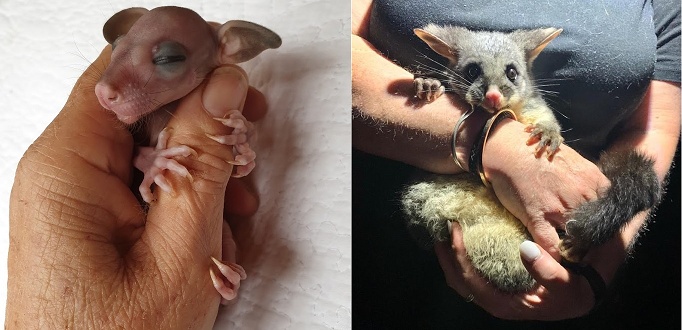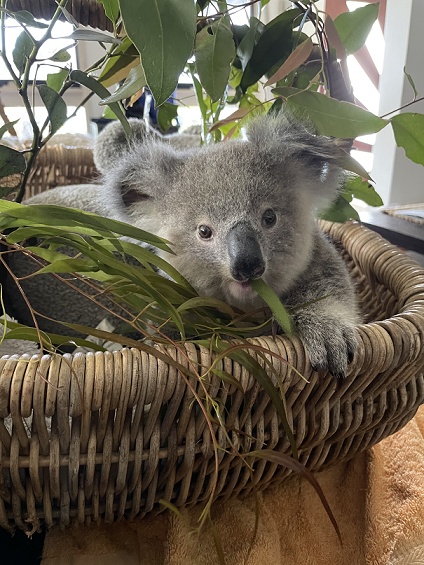
Being a registered charity operated entirely by volunteers, 2021 presented a number of challenges for Sydney Wildlife Rescue. While considered an essential service during the COVID-19 lockdown, our fundraising activities in the community were restricted, but sick, injured and orphaned wildlife still required rescue, rehabilitation and release.
The pandemic also affected our ability to recruit, train and induct new members, placing enormous demands on our resources ─ both human and financial. It could be described as a perfect storm, coming off the back of the devasting 2019/2020 bushfires, a severe weather event causing widespread flooding across Sydney in March, and the bumper spring fledging season.
Our 542 volunteers rose to the challenge, simply because of their love for our native animals. They continued to provide their own transport, equipment and food – some of which is subsidised by head office.
We reached out to a member in each of our five districts across range of species including reptiles, macropods, possums, koalas and birds to demonstrate just how much it costs to look after an animal in care and how people can support our efforts.
.jpg)
Lynleigh's reptile rehabilitation ward
Lynleigh Greig our Northern Beaches reptile coordinator reckons we’re on the money when we say reptiles are expensive to rehabilitate!
“I currently have seven snakes, two lizards, two turtles plus a sea snake in care and have just spent $312 buying frozen rats and mice, sterile substrate and heating equipment.”
According to Lynleigh, each reptile in care requires a specialised tank with a UVB lamp, basking lamp, heat-mat, thermostat and dimmer/timer. The thermostat/dimmers alone cost $87.45 each! The really sick ones also require a ceramic heat globe to stay on all night.
Turtles are even more difficult as their tanks require a filter and multiple heaters in addition to the basking globe and UVB lamps etc. They eat anything from crickets and blood worms to pinkie mice and fish which are all costly items. The really sick reptiles need to be tube-fed with a special mix which is about $4per tub.
“Snakes and goannas eat rats and mice which can sometimes cost as much as $12.50 per item and sea snakes have an entirely different set of requirements which can end up being extremely expensive.”
In summary, Lynleigh can spend anywhere between $80 and $400 a month on rehabilitating reptiles, depending on how many are in care and which species. And that doesn’t include electricity bills!
.jpg)
Lynleigh with Lace Monitor
“Collecting foliage can be very time consuming and they also need Roo Pellets or Roo Cubes which can cost as much as $75 for a $20kg bag.”
Then there’s Roo Milk which can be as much as $45 for a 1kg box, with one animal consuming this quantity in a month. They can also require probiotics which cost up to $90 for 500gm. On top of that there’s grassy mix which weighs in at around $25 a bale, not to mention equipment such as nipples for teats and heat pads.
“Fortunately, I have a good supply of carry bags thanks to generous donations made following the bushfires.”
Depending on how many macropods Jane has in care (sometimes up to six at a time) she could easily spend around $100 a week.

Phoebe the Swamp Wallaby
Bronwyn’s deliberately avoided keeping a record of the costs involved in caring for wildlife as it would be “eye watering.”
But she accepted our challenge, responding with multiple spreadsheets of data on the cost of raising baby brushtail possums to the stage of weaning (800 to 850 grams).Costs for the next four to five weeks (800 to 1000 grams) are mainly in terms of fruit and vegetable supplements.
To grow and thrive, baby possums need a special environment, mimicking the warmth of the mother’s pouch as much as possible. Bronwyn estimates the one-off cost for baby possum carers is approximately $550 to set up over time. This includes heat mat/warmers, regulators to control temperature range safely and prevent over or underheating, a thermometer with alarm, appropriately sized cages for graduation of possum’s environment and many small formula bottles with lids. New carers can often borrow these items from other carers for short-term use.
Caring for multiple babies means that multiples of these are needed. A luxury item for carers and the babies is an ICU unit ($800). These units provide a stable environment for tiny or ill babies.
She’s also estimated recurring costs at around $375 to raise each baby to release age and size. This includes formula, probiotic supplements, lanolin for skincare, fruit and veg, supplements, disinfectants and tiny teats, not to mention transport costs (including road tolls) and electricity. As they grow, each possum needs a possum box to snuggle into and later, to be released in.
Other items such as pouches/palaces/and liners, made by volunteers from all around the world, are often available free of charge from the Animal (ARC) Craft Guild. Basket liners and covers are made from old T-shirts and handtowels/ nappies/ cloths/ blankets usually sourced from around the house, friends and other carers.
Despite the costs, Bronwyn describes her volunteer work for Sydney Wildlife since 2015 as a much more rewarding “pastime” than golf, tennis or sailing, none of which she has any interest in at all.

Phoenix the Brushtail Possum
“He has cataracts in both eyes and most likely a congenital eye condition, so he’ll be part of a research program and in permanent care at the Port Macquarie Koala Hospital.”
Renee is often confronted with the dilemma of a koala being euthanised or fundraising for expensive operations. $2,000 was quoted if Diego was a candidate for eye surgery to resolve his issues, but after consulting specialists, sadly he wasn’t.
“Some contributions are anonymous, but where we know the details of the supporter, we try to acknowledge them by naming the koala after them.”
While some supplies are subsidised by Sydney Wildlife Rescue head office, the South West koala team spend countless hours collecting foliage for the koalas in care twice a day – morning and afternoon.
Her fellow volunteers also incur significant costs caring for the vulnerable koala population in Sydney’s southwest. Joint koala coordinator Rhonda Phillips has invested in purpose-built pre-release enclosures and community education officer Ricardo Lonza clocks up countless kilometres monitoring the species.
Although many of their aviaries are donated, other equipment such as nets, capture bags and microchip scanners to help identify the koalas can be costly.

Diego the Koala joey safely transferred to the Port Macquarie Koala Hospital
According to Lana, the cost of lots of little things adds up as different bird species need a variety of things to eat.
“We go out of our way to provide mealworms, crickets, mince balls and mice for kookaburras and tawny frogmouths in care.
Their branch is very fortunate to have a local wildlife centre that supplies these products at an extremely cheap rate.
“A ten-pack of pinkie mice for kookaburras, currawongs and ravens can cost between $30 and $40 and may only last a couple of days depending on how many birds are in care.”
“Raptors in particular require a diet high in calcium and protein, so pinkie rats are perfect!”
A brown goshawk which came into Lana’s care with one wing missing 90% of flight feathers will be in care until they grow back. He’s since been transferred to a wildlife care centre where they have the space he needs to continue his rehabilitation and keep up his flight muscles up.
.jpg)
This Brown Goshawk is now on the road to recovery
So, as you embark on the 12 days of Christmas and think about a gift for the person who has everything or contemplate your New Year’s resolutions for 2022, can we suggest:
1. DONATE by making a tax-deductible donation for a special person in your life who loves wildlife
2. ENROL in our next online Rescue & Care Course which is self-paced over 3 weeks with a follow up practical session and make like-minded friends supported by a dedicated ‘Buddy’ and species specialists
3. LEARN how to support our 24/7 rescue and advice line, which after training at our Lane Cove HQ can be done from the comfort of your own home
4. HELP by sourcing, collecting and delivering foliage and vegetation or chopping fruit for our critters in care or delivering equipment donated by generous members of the public
5. CONSTRUCT nest boxes or other equipment if you’re handy or part of a Men’s Shed or similar cooperative
6. MAKE your backyard wildlife friendly by planting natives, using wildlife friendly netting, avoiding herbicides, pesticides & insecticides, keeping domestic pets inside, reducing waste & recycling, installing a scamper ramp in your pool and providing fresh water for native wildlife
7. SUPPORT our community fundraising efforts by attending sausage sizzles, cake stalls and other events
8. WELCOME us into your community organisation, local school or nursing home for an educational talk
9. OFFER your skills in marketing, public relations, event coordination, content writing, social media or technical and administrative tasks
10. REACH OUT to your company and sponsor our organisation
11. REPORT sick, injured and orphaned wildlife to our 24/7 rescue and advice line
12. OR SIMPLY like, comment and share our social media and visit our new website.
Over the Festive Season, native wildlife still needs our help, so the Sydney Wildlife Rescue Line 9413 4300 will operate 24/7 and our dedicated volunteers will be on call. You can help us to help them by sharing this message and please be patient while they respond over this busy period.
We thank you again for your support throughout 2021 and wish you a Merry Christmas, Safe Holiday and Happy New Year as we look forward to celebrating our 25th year of service to the community in 2022.



